Aenert news. Invention analysis
Previously, we published articles concerning the offshore wind turbines (22/08/2022), and wind turbine blade de-icing technologies (30/12/2022). Here we will review patent documents related to the technologies lightning protection in wind turbine blades.
The importance of this aspect of wind turbine operation is indicated by the emergence in 2016 of a new IPC subgroup specifically assigned for lightning protection in wind turbines, and the ensuing growth in the number of new patent documents describing related technologies.
More than 380 patent documents published in the twenty-year period from 2001 to 2020 and related to lightning protection in wind turbine blades were collected for the present analysis by using Advanced Energy Technologies methodology. The collected documents were published in 16 patent offices of the world by 69 applicants from 10 countries.
Wind energy. Lightning protection in wind turbine blades. Relationship of number of applications to total number of documents by year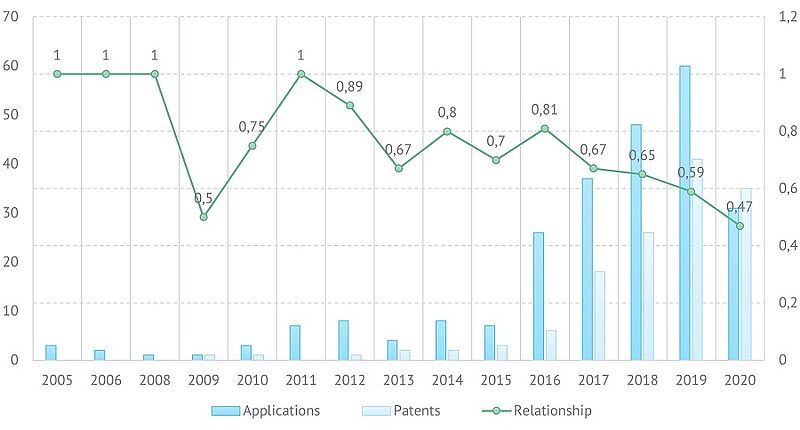
The chart above shows that starting from 2016 there was a rapid growth in the number of both granted patents and published patent applications. In both cases the peak value was achieved in 2019. Since 2015 the number of start documents not belonging to any previously formed patent family was varying in the range of 30%-57%. Also, this subject demonstrates the growth in annual appearance of new applicants and new IPC subgroups assigned to the patent documents. Although not showing a growth trend, the appearance of new patent offices in the collection of documents in the last years is steady. All this can indicate a growth in the interest of inventors in the development of these technologies and their expansion through the introduction of innovative technical solutions.
Almost 30% of all collected patents published between 2001 and 2020 were granted by the EPO and USPTO (US) patent offices. CNIPA (CN), and JPO (JP) each granted more than 10% of the collected patents. In terms of the number of recent patent applications, CNIPA (CN), USPTO (US), and EPO became the leaders by publishing about 20% of all applications each.
Wind energy. Lightning protection in wind turbine blades. Breakdown of inventions by patent offices. Patents, 2001-2020 (left); Applications, 2016-2020 (right)
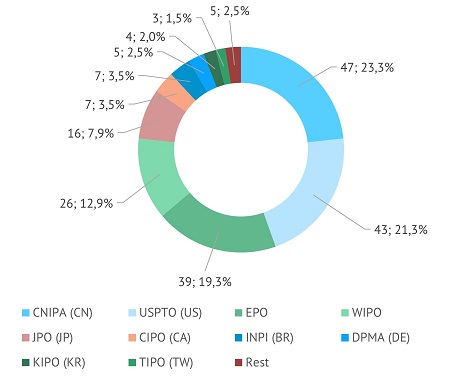
Residents of Denmark were leading by the number of patents granted during the 20-year period with a share of almost 37% of all cases. High patenting activity was also demonstrated by residents of Germany and Japan. For patent applications published in the past five years, the leaders were the residents of Denmark, Germany, and Japan, with the shares of nearly 50%, 20%, and 14%, respectively.
Below we provide a list of top 10 leading applicants for patents published in the 20-year period:
Wind energy. Lightning protection in wind turbine blades. Top applicants. Patents, 2001-2020
| Status | Country | Name | Average rating | Total 2001-2020 |
|---|---|---|---|---|
| Company | DK | Vestas Wind Systems A/S | 17.9 | 25 |
| Company | DK | LM WP Patent Holding A/S | 17 | 13 |
| Company | JP | Mitsubishi Heavy Industries, Ltd. | 17.2 | 11 |
| Company | DE | Wobben Properties GmbH | 16.6 | 11 |
| Company | US | General Electric | 18.1 | 10 |
| Company | DE | Siemens AG | 17.4 | 8 |
| Company | JP | Hitachi, Ltd. | 17.6 | 7 |
| Company | DE | Nordex Energy Gmbh | 16 | 7 |
| Company | ES | Gamesa Innovation & Technology S.L. | 16.2 | 5 |
| Company | JP | Japan Steel Works Ltd | 11.5 | 4 |
Among all of the applicants participating in the selection of documents under consideration, Vestas Wind Systems A/S (DK) had the highest Market involvement ratio for patents published during the 20-year period – almost 19% (Market involvement ratio = volume ratio multiplied by ownership ratio, where Volume ratio - share of applicant documents in total number of documents, Ownership ratio - applicant's participation share in total number of documents). It was followed by LM WP Patent Holding A/S (DK) (nearly 10%) and Wobben Properties GmbH (DE) (more than 8%). In the collection of recent applications, the top three applicants in this respect were Vestas Wind Systems A/S (DK), Wobben Properties GmbH (DE), and Siemens Gamesa Renewable Energy A/S (DK), with about 21%, 13% and 8%, respectively.
Wind energy. Lightning protection in wind turbine blades. Top applicants. Applications, 2016-2020
| Status | Country | Name | Average rating | Total 2016-2020 |
|---|---|---|---|---|
| Company | DK | Vestas Wind Systems A/S | 13.2 | 43 |
| Company | DE | Wobben Properties GmbH | 11.5 | 25 |
| Company | DK | Siemens Gamesa Renewable Energy A/S | 9.9 | 15 |
| Company | ES | Gamesa Innovation & Technology S.L. | 11 | 11 |
| Company | US | General Electric | 13.9 | 11 |
| Company | JP | Hitachi, Ltd. | 12.5 | 8 |
| Company | JP | Mitsubishi Heavy Industries, Ltd. | 12.7 | 7 |
| Company | DK | Polytech A/S | 11.3 | 7 |
| Company | DK | LM WP Patent Holding A/S | 14 | 6 |
| Company | DE | Senvion Deutschland GmbH | 12.8 | 6 |
When considering problems, the inventions related to wind turbine blade lightning protection aim to solve, Low efficiency caused by secondary natural factors comes first in both patents granted in the 20-year period and applications for the past five years, followed by High OPEX / Repair and replacement in both cases. Device is the type of technical solutions the inventors mainly chose for their inventions. The number of inventions disclosing novel methods is much smaller, while new compositions barely appear in the revised collection of documents. In addition to the IPC subgroups defining the selection of patent documents used for the present analysis (F03D80/30, H02G13/00), the most popular IPC subgroups were F03D1/06 (Rotors), F03D11/00 (Details, component parts, or accessories not provided for in, or of interest apart from, the other groups of this subclass), F03D80/40 (Ice detection; De-icing means), B29C70/88 (characterised primarily by possessing specific properties, e.g. electrically conductive or locally reinforced), and H05F3/04 (by means of spark gaps or other discharge devices).
In the collection of documents under consideration, the largest patent families comprise 23, 15, and 13 patent documents and are represented by core documents US20160090963A1, US9169826B2, and US20160195068A1, respectively (Core document is a base document for which a complete description of the invention is available in generally-accessible patent databases):
ROTOR BLADE TIP / A: US20160090963A1 / IPC: F03D1/06 / Hoffmann Alexander, Dulle Dennis, Clemens Christian / WOBBEN PROPERTIES GMBH / Appl. date: 06/11/2013; Publ. date: 31/03/2016 / United States Patent and Trademark Office / Core document: US20160090963A1 / Technology categories: HWT / Technology elements: B / Problems: HCP, LEN / Technical solution types: D / Claims: 20 / Rating: 13
Lightning protection structure of blade for wind power generation / P: US9169826B2 / IPC: F03D11/00, F03D1/06, H02G13/00 / Muto Atsutoshi / THE JAPAN STEEL WORKS LTD, Muto Atsutoshi / Appl. date: 03/02/2011; Publ. date: 27/10/2015 / United States Patent and Trademark Office / Core document: US9169826B2 / Technology categories: WTU / Technology elements: B, CSS / Problems: LEN / Technical solution types: D / Claims: 5 / Rating: 12
Lightning Protection System For A Wind Turbine / A: US20160195068A1 / IPC: 0 / Olsen Kaj / Siemens Ag / Appl. date: 16/03/2016; Publ. date: 07/07/2016 / United States Patent and Trademark Office / Core document: US20160195068A1 / Technology categories: HWT / Technology elements: B / Problems: LEN / Technical solution types: D / Claims: 11 / Rating: 13
The following abbreviations are used in the documents hereinbefore and hereinafter: D - Device; M - Method; HWT - Horizontal axis wind turbine in general; WTU - Wind turbine type unspecified; B - Blades and components thereof; CSS - Control and safety systems; MRR - Maintenance, repair and replacement; ESI - Environmental and social impact; HCC - High CAPEX / Plant construction; HCP - High CAPEX / Equipment production; HOR - High OPEX / Repair and replacement; LEN - Low efficiency caused by secondary natural factors.
Following are several examples of patent documents having the highest rating calculated using Advanced Energy Technologies methodology, from the pool of documents related to lightning protection in wind turbine blades:
Wind energy. Lightning protection in wind turbine blades. Prominent patent documents by rating, 2001-2020:
Tip extensions for wind turbine rotor blades and methods of installing same / P: US10443579B2 / IPC: F03D80/30, F03D1/06 / Tobin James Robert, Hardison Richard, Livingston Jamie T / Gen Electric / Appl. date: 15/11/2016; Publ. date: 15/10/2019 / United States Patent and Trademark Office / P/A pair: US20180135602A1 / Technology categories: HWT / Technology elements: B / Problems: ESI, HCC, HOR, LEN / Technical solution types: D, M / Claims: 17 / Rating: 21
Spar cap for a wind turbine rotor blade / P: US9816482B2 / IPC: F03D1/06, F03D13/20, F03D80/30 / Caruso Christopher Daniel, Yarbrough Aaron A, Hardison Richard Allen / General Electric Company / Appl. date: 17/11/2014; Publ. date: 14/11/2017 / United States Patent and Trademark Office / Core document: EP3020958A1 / Technology categories: HWT / Technology elements: B / Problems: HOR, LEN / Technical solution types: D, M / Claims: 18 / Rating: 21
Method of testing wind-turbine receptor / P: US10401414B2 / IPC: G01R31/02, B64C39/02, F03D1/06, F03D17/00, F03D80/30 / Matsushita Takatoshi, Ota Keisuke, Hasegawa Osamu, Imaoka Kengo, Fukami Koji / Mitsubishi Heavy Ind Ltd / Appl. date: 08/02/2017; Publ. date: 03/09/2019 / United States Patent and Trademark Office / Core document: US20170248647A1 / Technology categories: HWT / Technology elements: B, MRR / Problems: HCC, HOR / Technical solution types: D, M / Claims: 13 / Rating: 20
METHOD OF TESTING WIND-TURBINE RECEPTOR / P: EP3211226B1 / IPC: B64C39/02, F03D1/06, F03D17/00, F03D80/30, G01R31/02, G01R31/44 / Matsushita Takatoshi, Ota Keisuke, Hasegawa Osamu, Imaoka Kengo, Fukami Koji / MITSUBISHI HEAVY INDUSTRIES, LTD. / Appl. date: 19/01/2017; Publ. date: 16/01/2019 / European Patent Organisation / Core document: US20170248647A1 / Technology categories: HWT / Technology elements: B, MRR / Problems: HCC, HOR / Technical solution types: D, M / Claims: 10 / Rating: 20
Wind Turbine Blades and Potential Equalization Systems / P: CA3009249C / IPC: F03D80/30 / Nielsen Lars, Jespersen Klavs / Lm Wp Patent Holding As / Appl. date: 19/12/2016; Publ. date: 07/07/2020 / Canadian Intellectual Property Office / Core document: US20190003462A1 / Technology categories: HWT / Technology elements: B, CSS / Problems: HOR / Technical solution types: D, M / Claims: 16 / Rating: 20
Wind turbine blades and potential equalization systems / P: US10584684B2 / IPC: F03D1/06, F03D80/30 / Nielsen Lars, Jespersen Klavs / Lm Wp Patent Holding As / Appl. date: 19/12/2016; Publ. date: 10/03/2020 / United States Patent and Trademark Office / Core document: US20190003462A1 / Technology categories: HWT / Technology elements: B, CSS / Problems: HOR / Technical solution types: D, M / Claims: 18 / Rating: 20
Wind turbine blade with an integrated lightning conductor / P: US8896980B2 / IPC: H02G13/00 / Kristensen Jens Jorgen Ostergaard, Olsen Kaj / Siemens Aktiengesellschaft, Kristensen Jens Jorgen Ostergaard, Olsen Kaj / Appl. date: 05/04/2012; Publ. date: 25/11/2014 / United States Patent and Trademark Office / Core document: US8896980B2 / Technology categories: WTU / Technology elements: B / Problems: HOR / Technical solution types: D, M / Claims: 8 / Rating: 20
Among the patents and patent applications published over the 20 years and collected for this analysis, the largest number of documents were solving the following problems: Low efficiency caused by secondary natural factors, High OPEX / Repair and replacement, High CAPEX / Equipment production, and High OPEX / Operational maintenance. Below are several examples of patent documents that concern lightning protection technologies in wind turbine blades and to some extent aim at solving the mentioned problems:
- US20190195203A1 – the invention discloses a reliable and high-performance lightning protection system comprising a metal foil extending along the blade area and two metallic lightning receptors;
- US10156226B2 – an improved efficiency lightning protection system comprising a lightning conductor, a lightning receptor module with discrete lightning receptors, and an elongate receptor band positioned over the receptors and having a crease;
- US10584684B2 – delamination damage from lightning strikes is reduced by a wind turbine blade structure comprising stacked fibre layers and a lightning protection system including potential equalization system with a dissipating element positioned on the fibre layers and connectors extending through the layers;
- US10519936B2 – a lightning receptor that can be produced simply and cost-effectively comprises a one-part body produced in a casting process, having a fastening portion with a connection for a lightning conductor and two adhesive bonding surfaces providing a secure hold and ease of replacement;
- US20200173423A1 - wind turbine blade maintenance is facilitated by a lightning detection system comprising a set of lightning receptors and conductors measuring the parameters of lightning striking the blade and the parameters of current leaving the blade.
Low efficiency caused by secondary natural factors
Patent application US20190195203A1 filed by Mitsubishi Heavy Industries, Ltd. (JP) and Fujioka Hideyasu (JP) discloses a wind turbine blade with a lightning protection system. The system comprises a metal foil that is arranged near the outer surface of the blade, and that extends from the tip end area towards the root end area of the blade. The lightning protection system comprises a first metallic lightning receptor between the metal foil and the tip end of the blade, and in direct electrical contact with the metal foil. The first receptor comprises copper, is flat-shaped or bar-shaped, and tapers towards the tip end of the blade. It "…is covered only by a thin protective layer in the radial outer direction of the blade", and extends over the entire blade surface in the tip end area continuously from the metal foil to the blade tip end. The first receptor is overlapping with the metal foil forming an overlap section, where they are clamped between two metal plates and connected to each other. The lightning protection system further comprises a disk receptor near the end of the metal foil. The system also comprises a second metallic lightning receptor (a rod receptor comprising a base plate and a disk receptor) in electrical contact with the first receptor and disposed at the tip end of the blade. The second metallic lightning receptor comprises a solid copper blade tip with means for connecting to the first receptor.
The authors of the invention point out the need in a reliable and high-performance lightning protection system for a wind turbine.
The invention belongs to a family comprising 12 patent documents published in EP, WO, KR, CN, and US between 2013 and 2019.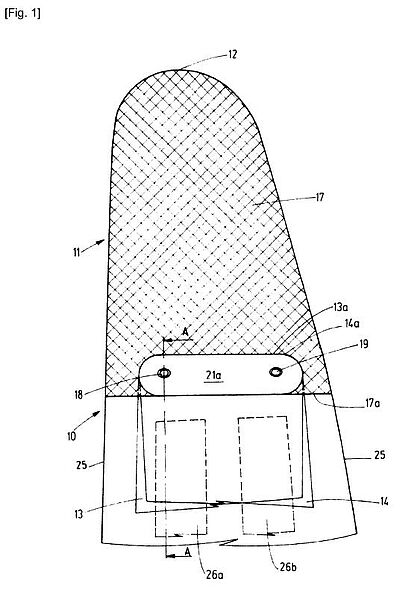
Image from: US20190195203A1
10 - wind turbine blade; 11 - tip end area; 12 - tip end; 13,14 - metal foil; 13a,14a,17a - first end; 17 - first metallic lightning receptor; 18,19 - disk receptor; 21a - base plate; 25 - outer blade layer; 26a,26b - spar cap
Patent US10156226B2 granted to Vestas Wind Systems A/S (DK) describes a lightning protection system of a wind turbine blade, comprising a lightning conductor located along the blade and being coupled to an electrical ground, and a lightning receptor module including discrete lightning receptors on an external surface of the blade, electrically coupled to the conductor. The system further includes a metallic elongate receptor band installed in a longitudinal direction along the surface of the blade by an adhesive, over the discrete receptors of the receptor module to receive a strike of lightning. The band is of substantially uniform thickness and comprises a crease in a longitudinal cross-sectional profile of the band, a corrugated longitudinal cross-sectional profile, and upper and lower surfaces. The crease "…is defined by at least one first apex in the upper surface and at least one second apex in the lower surface", the second apex being in contact with the receptor module. The receptor band comprises an electrically conductive portion where the crease is positioned, the portion has one surface contacting the blade, and a second surface being exposed.
The authors mention that typical existing lightning protection systems are not sufficiently effective.
The patent is a part of a patent family consisting of 10 documents published from 2013 to 2018 in US, WO, IN, EP, and CN.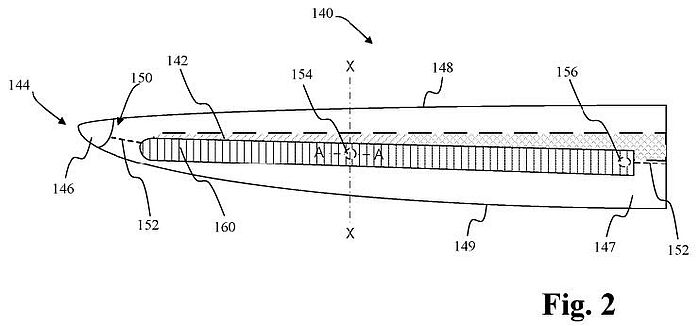
Image from: US10156226B2
140 - blade; 142 - load-bearing spar; 144 - blade tip; 146 - tip receptor; 147 - windward surface; 148 - leading edge; 149 - trailing edge; 150 - blade lightning protection system; 152 - down conductor; 154,156 - side receptor; 160 - elongate receptor band
High OPEX / Repair and replacement
A wind turbine blade is proposed in patent US10584684B2 by LM WP Patent Holding A/S (DK). The blade includes a load carrying structure with a fibre-reinforced polymer material and a number of stacked fibre layers comprising conductive carbon fibres, and a lightning protection system comprising a freely accessible lightning receptor and a down-conductor connected to the receptor and to a ground connection. The blade further comprises a system providing a potential equalizing connection between the load carrying structure and the lightning protection system. Such potential equalization system includes a conductive dissipating planar element and transverse connectors (a spike, a needle, a hook, a staple, or their combination) extending through at least three stacked fibre layers to dissipate energy into the layers and arranged on the planar element according to a pre-determined distance between juxtaposed transverse connectors. The dissipating planar element is made of copper, aluminium, silver, gold or their combinations, in a form of mesh, grid, or plate, and covers a surface area between 0.5m2 and 2m2. "…The dissipating element comprises at least one connection and a mesh with at least one crossing, wherein at least one spike extends from the at least one crossing". The dissipating element is positioned on an innermost one of the fibre layers.
According to the authors of the invention, the blade of such structure is protected from delamination damages caused by lightning.
The patent belongs to a patent family consisting of 10 documents published in US, BR, CA, CN, EP, and WO in 2017-2020.
Image from: US10584684B2
400 - wind turbine blade; 41 - load carrying structure; 42 - potential equalization system; 43 - shear web; 46 - blade shell; 47 - lightning receptor; 48 - connection; 49 - lightning down-conductor
High CAPEX / Equipment production
A wind turbine blade lightning receptor is described in patent US10519936B2 by Nordex Energy Gmbh (DE). The lightning receptor comprises a one-part body produced in a casting process, having a tip, a suction side, a pressure side, a nose edge, an end edge. "…said lightning receptor body further defining a fastening portion with two mutually opposite adhesive bonding surfaces which are formed by recesses in said receptor pressure side and in said receptor suction side". The recesses are rectangular or trapezoidal and have a depth from 1 mm to 10 mm, while the adhesive bonding surfaces of the fastening portion have bores. The fastening portion further has a connection for a lightning conductor, an end face and an end, where the end is disposed remote from the receptor tip, but end face is closer to the tip, has a concave curvature and connection arrangement. The receptor body further comprises a receptor-nose-edge-side leg and a receptor-end-edge-side leg projecting beyond the fastening portion away from the receptor tip. "…The adhesive bonding surfaces are arranged in an inwardly offset manner relative to said receptor pressure side or relative to the receptor suction side." The receptor body is made of metal, such as aluminium, copper, or an alloy.
Among the advantages of the invention the authors mention that the lightning receptor can be produced simply and cost-effectively.
The invention is a part of a family consisting of 4 documents published in 2017 and 2019 in US and EP.
Image from: US10519936B2
24 - lightning receptor; 26 - receptor tip; 28 - receptor nose edge; 30 - receptor end edge; 32 - receptor suction side; 34 - receptor pressure side; 36 - fastening portion; 38,40 - adhesive bonding surfaces; 42 - first portion; 44 - second portion; 46 - threaded bore; 48 - third portion; 50 - bores; 52,53 - Recess; 54 - Edge; 56 - Nose-edge-side leg; 58 - End-edge-side leg; 60 - End face; 64 - Drainage bore
High OPEX / Operational maintenance
Patent application US20200173423A1 by Polytech A/S (DK) describes a lightning detection system and method for wind turbine blades. The system includes a blade lightning ground conductor, a number of lightning receptors, a number of individual lightning detectors to measure a parameter of the magnitude of a lightning current, and a main blade ground conductor lightning detector to measure a magnitude of lightning current leaving the blade. The main blade ground conductor lightning detector can be powered externally, includes a sensor (e.g. a Rogowski coil), a microprocessor, a memory storage, and a wireless communication module, and is a adapted to measure such parameters as peak current, polarity, charge, rise time, and specific energy. Each individual lightning detector is integrated into an electrically insulated implant, and comprises a sensor (e.g. a Hall effect sensor), a microprocessor, a memory storage, a wireless communication module, a battery, a device to harvest power from such sources as motion, vibration, and light. The system also comprises a central wireless communication module to communicate with respective modules of the lightning detectors. Wireless communication modules of individual lightning detectors can communicate with the central module directly, or indirectly via other individual modules, for instance, in cases of low battery level. The blade lightning ground conductor is associated with the lightning detectors and connected to lightning receptors to measure a magnitude parameter of a lightning current flowing through a part of the blade lightning ground conductor after striking lightning receptors. The application further descries a method of operation of the lightning detection system.
According to the description of the invention the system can reduce operational expenditure and enable preventative maintenance.
The application belongs to a patent family of 6 patent documents published in US, BR, CN, EP, WO, and JP in 2019 and 2020.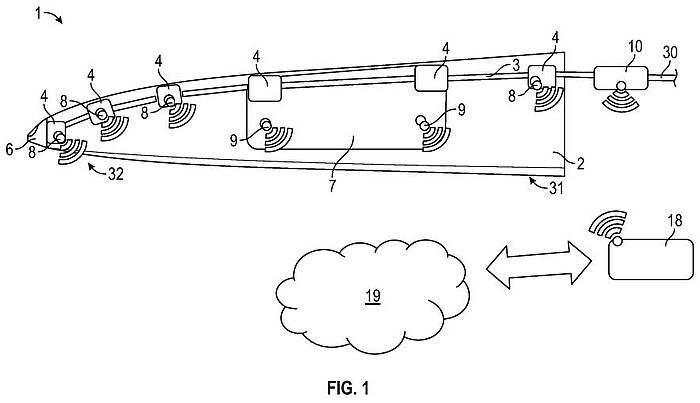
Image from: US20200173423A1
1 - lightning protection system; 2 - wind turbine blade; 3 - blade lightning ground conductor; 4 - lightning receptor; 6 - blade tip lightning receptor; 7 - lightning receptor; 8 - individual central lightning detector; 9 - individual side lightning detector; 10 - main blade ground conductor lightning detector; 18 - central wireless communication module; 19 - cloud server; 30 - end of blade lightning ground conductor; 31 - root end of wind turbine blade; 32 - tip end of wind turbine blade
As can be seen from the documents described above, and based on the other documents revised during the preparation of this article, in the majority of cases the proposed technical solutions describe various designs and elements of lightning receptors and lightning conductors, and options for their integration into a wind turbine blade.
More detailed information about inventions in the field of wind energy, and patent research methodology can be found on aenert.com.
By the Editorial Board
